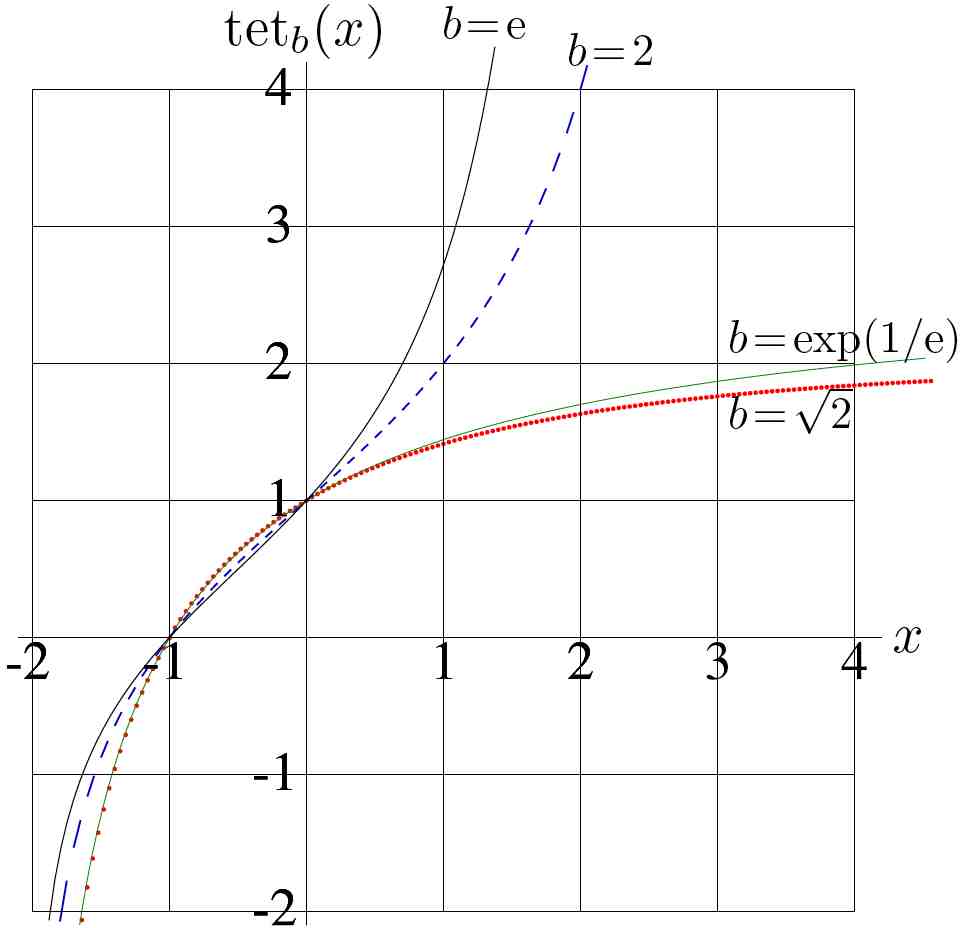A( 2 , z) = A( 1 , A(2,z-1) ) = b + A(2,z-1)
The equation F(z) = b + F(z-1) has obvious solution F(z) = b z .
In such a way, the second ackermann is just multiplication by constant b.
A( 2 , z) = b z
Using the second ackermann, one can express the third one. Repeating the similar substitutions, one finds that the third Ackermann is just exponentiation to base b
A( 3 , z) = bz
 In such a way, the ackermanns can be built up one by one. The evaluation of each ackermann, while the previous one is already implemented, can be done either with the Cauchi integral or with the regular iteration. (Some other methods are also reported, but they seem to be non efficient.) For the precise evaluation of the multiplication, the good skills in summation are necessary. For the evaluation of exponentiation, one needs both, the summation and multiplication; in addition, the inverse functions, id est, subtraction and the division also should be implemented. The fourth ackermann, defined in such a way, can be called tetrational and denoted with symbol tet; it is shown in the figure for base
b=sqrt(2) approximately 1.414...,
b=exp(1/e) approximately 1.44...,
b=2,
b=e approximately 2.71...
In such a way, the ackermanns can be built up one by one. The evaluation of each ackermann, while the previous one is already implemented, can be done either with the Cauchi integral or with the regular iteration. (Some other methods are also reported, but they seem to be non efficient.) For the precise evaluation of the multiplication, the good skills in summation are necessary. For the evaluation of exponentiation, one needs both, the summation and multiplication; in addition, the inverse functions, id est, subtraction and the division also should be implemented. The fourth ackermann, defined in such a way, can be called tetrational and denoted with symbol tet; it is shown in the figure for base
b=sqrt(2) approximately 1.414...,
b=exp(1/e) approximately 1.44...,
b=2,
b=e approximately 2.71...
The fifth ackermann can be called pentational, the sixth can be called sextational and so on. The first three ackermanns are entire functions; the fourth one, i.e., the tetrational, has the logarithmic singularity at -2 and cut in the negative direction of the real axis. Behavior of the highest ackermanns, id est, A(k,z) at k>4, is not yet well investigated, but it is recognized that they show fast growth along the positive direction of the real axis, and this growth with respect to the first argument is faster, than that with respect to the second argument. The holomorphic extension with respect to the first argument is not yet reported, although I suspect that this is doable.
Conclusion
The most of the mathematical analysis of IXX-XX centuries is based on the first three ackermans: summation, multiplication, exponentiation and their inverse functions. The functions, that can be expressed in terms of these operations in closed form are called elementary functions: log, sqrt, sin, cosh, arctan, etc. Some functions can be expressed in terms of simple differential or integral equations with elementary functions; many such functions are called special functions (for esample, bessel, erfc, fresnelC, fresnelS, etc. ).
Sometimes, one calls the solution of some problem exact or analytic, if it is expressed in terms of the special functions or simple integrals with special functions. The use of the higher ackermanns as special functions could extend the class of problems that allow such an "exact" ("analytic") solution.
References
W.Ackermann. Zum Hilbertschen Aufbau der reelen Zahlen. Mathematische Annalen, v.99, (1928), p.118-133.
http://portail.mathdoc.fr/PMO/PDF/E_ECALLE_67_74_09.pdf J.Ecalle. Theorie des invariants holomorphes. Publications d'mathematiques d'Orsay. no 67-74 09, 1970, Universite Paris XI, U.E.R. Mathematique, 91405 Orsay, France.
R.A.Knoebel. Exponentials reiterated. American Mathematics monthly, v.88, No.4, April 1981, pp, 235-252; especially, see page 247.
http://www-history.mcs.st-and.ac.uk/history/Biographies/Ackermann.html
http://www.ams.org/mcom/2009-78-267/S0025-5718-09-02188-7/home.html D.Kouznetsov. Analytic solution of F(z+1)=exp(F(z)) in complex z-plane. Mathematics of Computation, v.78 (2009), 1647-1670.
http://www.ils.uec.ac.jp/~dima/PAPERS/2009analuxpRepri.pdf D.Kouznetsov. Analytic solution of F(z+1)=exp(F(z)) in complex z-plane, preprint
http://www.ils.uec.ac.jp/~dima/PAPERS/2008ackermann.pdf D.Kouznetsov. Ackermann functions of complex argument. Preprint ILS, 2008. (The old definition, with linear conjugated function is used there, and perhaps there are other defects there, but the update is not yet ready)
Texts in Vera on related topics
http://budclub.ru/k/kuznecow_d_j/ackermannr.shtml Функции Аскермана (Russian version of this article)
http://budclub.ru/k/kuznecow_d_j/mathematics.shtml Mathematics
http://budclub.ru/k/kuznecow_d_j/mathematicalproblems.shtml Mathematical problems
http://budclub.ru/k/kuznecow_d_j/mizugade.shtml Mizugadro's number
http://budclub.ru/k/kuznecow_d_j/nihilisttaboo.shtml Taboos
http://budclub.ru/k/kuznecow_d_j/philosophy.shtml Philosophy
http://budclu.ru/k/kuznecow_d_j/physics.shtml Physics
http://budclub.ru/k/kuznecow_d_j/2010mestoe.shtml Place of Science in the human knowledge
http://budclub.ru/k/kuznecow_d_j/science.shtml Science
http://samlib.ru/k/kuznecow_d_j/000abc.shtml#e Alphabetic index of texts in Vera
Copyleft 2009-2011 by Dmitrii Kouznetsov. This text may be used for free, attribute http://budclub.ru/k/kuznecow_d_j/ackermannr.shtml
The feedback navigation below is in Russian. To leave a comment, you should press the bottom "Оставить комментарий" and then, after to type in the frame, press the left button (it is marked as "Добавить!") at the bottom of the typing frame.